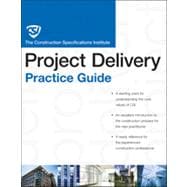
THE CONSTRUCTION SPECIFICATIONS INSTITUTE (CSI) is a national association dedicated to creating standards and formats to improve construction documents and project delivery. The organization, which has 146 chapters, is unique in the industry in that its members are a cross-section of specifiers, architects, engineers, contractors, and building materials suppliers. CSI is renowned in the industry for its rigorous certifi cation programs for professionals seeking to improve their knowledge of accurate and concise construction documents.
Acknowledgments.
Chapter 1: Introduction to The CSI Project Delivery Practice Guide.
1.1 Introduction.
1.2 Understanding Project Delivery as Foundational Knowledge.
1.3 Magnitude of Design and Construction Information Available.
1.4 Managing Information.
1.5 The Nature of the Project and Facility.
Chapter 2: Stakeholders and Participants.
2.1 Introduction.
2.2 The Owner Team.
2.3 The Design Team.
2.4 The Contractor Team.
2.5 The Supplier Team.
2.6 Team Selection Process.
2.7 Partnering and Collaboration.
2.8 Commissioning.
Chapter 3: Facility Life Cycle.
3.1 Introduction.
3.2 The Nature of the Facility Life Cycle.
3.3 Integrated Project Delivery.
3.4 Construction Specifications Institute.
Chapter 4: Codes, Regulations, and Standards.
4.1 Introduction.
4.2 Authorities Having Jurisdiction.
4.3 Codes.
4.4 Regulations.
4.5 Standards.
4.6 Associations, Societies, Councils, and Institutes.
Chapter 5: Contracts and Legal Issues.
5.1 Introduction.
5.2 Owner, Architect/Engineer, and Contractor Tripartite Relationships.
5.3 Elements of a Contract.
5.4 Standard Agreement Forms.
5.5 Example—Contract between Owner and Contractor.
5.6 Contract Types.
5.7 Form of Agreement.
5.8 Compatibility of Agreements.
5.9 Design Team Coordination.
5.10 Important Legal Issues.
Chapter 6: Project Planning.
6.1 Introduction.
6.2 Project Conception.
6.3 Due Diligence Investigations.
6.4 Site Selection.
6.5 Facility Programming.
6.6 Facility Performance Criteria.
6.7 Anticipating the Cost of the Work.
6.8 Setting the Scheduling.
Chapter 7: Project Delivery.
7.1 Influencing Factors.
7.2 Design-Bid-Build.
7.3 Design-Negotiate-Build.
7.4 Construction Management.
7.5 Design-Build.
7.6 Owner-Build.
7.7 Integrated Project Delivery.
Chapter 8: Design.
8.1 Introduction.
8.2 Dual Nature of Design.
8.3 Design Considerations.
8.4 Aesthetics.
8.5 Functional Requirements.
8.6 Constructability.
8.7 Sustainability.
8.8 Design Phases.
8.9 Quality Assurance/Quality Control Requirements.
8.10 Budgets.
8.11 Cost Estimates.
8.12 Life Cycle Costs.
8.13 Value Analysis.
8.14 Controlling Variables.
Chapter 9: Design Documents.
9.1 Introduction.
9.2 Design Concept Phase Documentation.
9.3 Schematic Design Phase Documentation.
9.4 Design Development Phase Documentation.
Chapter 10: Product Selection and Evaluation.
10.1 Introduction.
10.2 Types of Products.
10.3 Importance of Product Selection and Evaluation.
10.4 Obtaining Product Information.
10.5 The Evaluation and Selection Process.
10.6 Services That Product Representatives Provide.
Chapter 11: Construction Documents.
11.1 Introduction to Construction Documents.
11.2 Drawings.
11.3 Specifications.
11.4 Procurement Requirements.
11.5 Contracting Requirements.
Chapter 12: Procurement.
12.1 Introduction.
12.2 Pricing Methods.
12.3 Purchasing.
12.4 Pricing Considerations.
12.5 Competitive Pricing.
12.6 Project Information.
12.7 Bidding.
12.8 Negotiating Process.
12.9 Purchasing of Goods.
12.10 Subcontracting.
Chapter 13: Construction.
13.1 Introduction.
13.2 Construction as a Team Activity.
13.3 Roles and Responsibilities.
13.4 Preconstruction.
13.5 Meetings.
13.6 Submittals.
13.7 Site Visits, Observations, and Inspections.
13.8 Quality Assurance and Quality Control.
13.9 Interpretations and Modifications.
13.10 Executing the Work.
13.11 Claims and Disputes.
13.12 Measurement and Payment.
13.13 Project Closeout.
Chapter 14: Facility Management.
14.1 Transition.
14.2 Occupancy.
Index.
The New copy of this book will include any supplemental materials advertised. Please check the title of the book to determine if it should include any access cards, study guides, lab manuals, CDs, etc.
The Used, Rental and eBook copies of this book are not guaranteed to include any supplemental materials. Typically, only the book itself is included. This is true even if the title states it includes any access cards, study guides, lab manuals, CDs, etc.